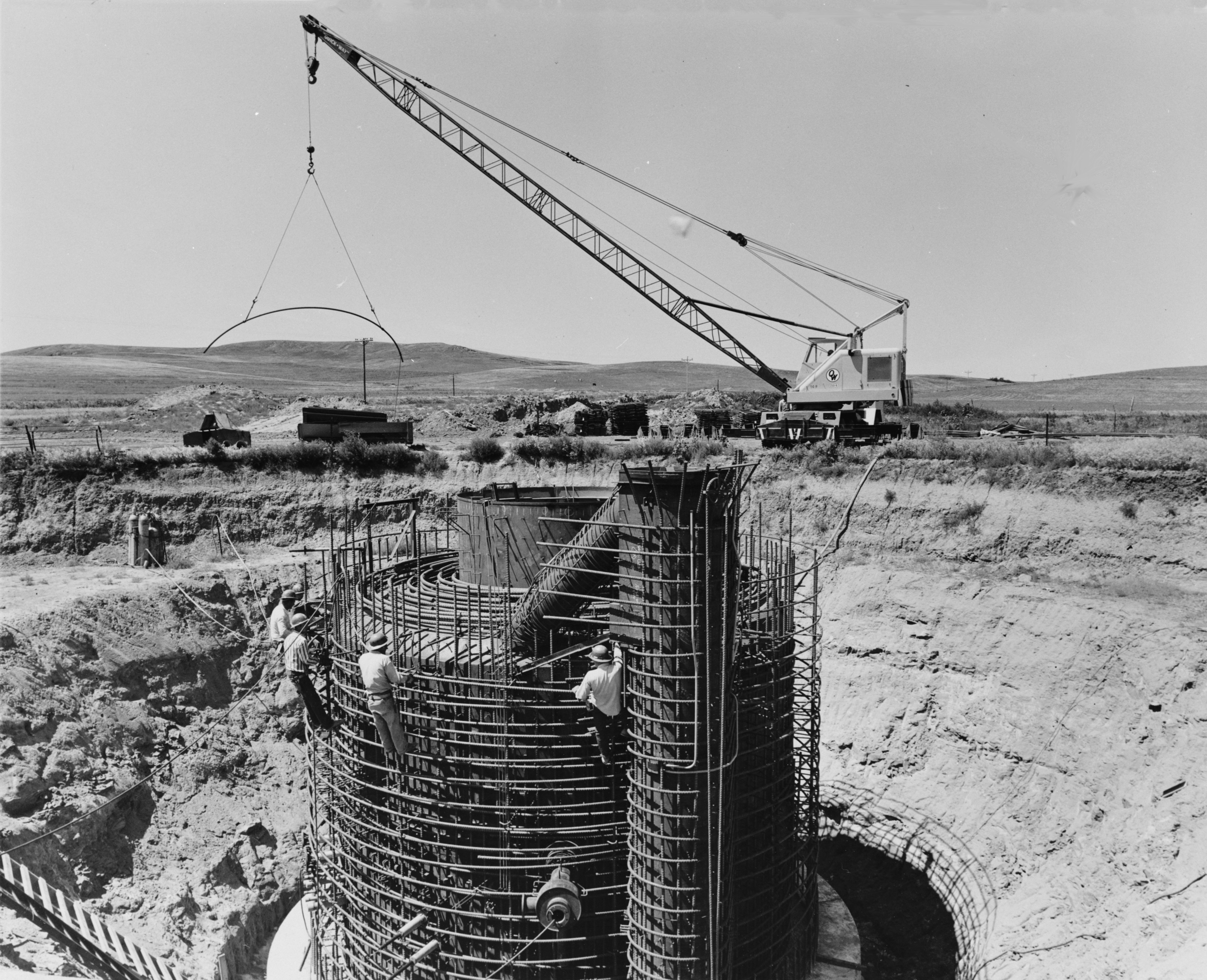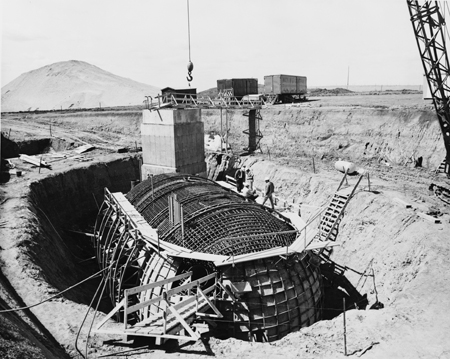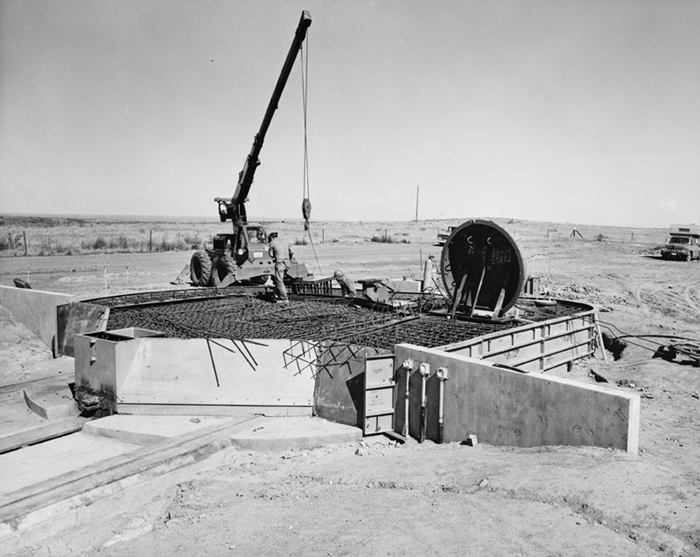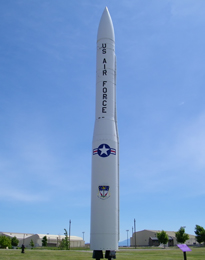
Launch Facility Rebar Liner

Launch Control Center Ellsworth AFB
Minuteman Missile Construction History

Pouring Concrete - Launcher Closure Door
While research and development of the Minuteman missile continued to move forward at a considerable pace, the Air Force Ballistic Missile Committee, under the command of General Bernard Schriever, approved the selection of Malmstrom Air Force Base, Montana, as the location to build the first Minuteman missile base. General Schriever submitted his approval on December 23, 1959.
The Corps of Engineer Ballistic Missile Construction Office was tasked with the design and supervision of the construction of the 15 Launch Control Centers and 150 Launch Facilities (silos). To make this plan possible, a significant amount of preparation was needed in a number of areas.
This preparation was assigned to the Seattle District of the Corps of Engineers. They were responsible for studying the feasibility of prospective sites. They also conducted surveys, soil and water tests, as well as having to determine the source for utilities, for both the Launch Control Centers and Launch Facilities.
The land acquisition in and of itself proved to be a monumental task, given the short period of time that was alloted to this construction project. This acquisition consisted of approximately 5200 tracts encompassing an area of over 20,000 square miles in Central Montana.
At the height of the construction project, the Corps of Engineers had over 80 people in its employ at their real estate office and these employees were faced with working with over 1350 owners of the desired land parcels.
Modifications in the launch facility design required the Corps of Engineers to renegotiate the easement agreements with the land owners a total of 12 times in the four year time period of the construction project. At the Malmstrom Air Force Base missile field, the government acquired the land through condemnation in less than 3 percent of the cases.
Once the construction was under way, tempers and patience were pushed as trenches for numerous miles of Hardened Intersite Cable System, (HICS) were dug, making it extremely difficult for the ranchers and farmers to get to and from their cattle and wheat fields. Fences were dismantled, some crops were destroyed and often times water and power supplies were disrupted.
Given the significant inconvenience experienced by the local farmers and ranchers, for the most part they were able to tolerate the chaos and commotion in their lives. A number of these individuals understood the gravity of the situation that necessitated this enormous construction project.
Winning bids for the construction contract was given to two construction companies, the George A Fuller Company and the Del E. Webb Corporation, who won the joint contract. The winning bid for these two companies totaled $61.7 million.
A ground breaking ceremony was held on March 16, 1961, with a number of key figures in attendance. A mix of key state and local politicians, combined with military, labor and contractor leaders in attendance,all gathered on stage at Malmstrom AFB. At the scheduled moment, eight selected individuals threw switches, setting off explosive charges at various missile sites. Each official received his switch as a memento.
Awareness of the cost overruns caused by the inevitable design modifications and the unanticipated surprises that often occur during construction, prompted the Corps of Engineers Ballistic Missile Construction Office to create a system in which excessive costs would be split, and the contractor would be responsible for picking up 25 percent of those costs. Using this system, the final project at Malmstrom AFB came out to $79,284,385.
Construction was faced with the anticipated design changes, slowing their progress, in addition to the unanticipated water tables, which necessitated additional pumping capacity at the excavation sites. The on site electricians had a strike from November 1 through November 12, 1961. Spring storms in 1962 also contributed to a reduction in progress during construction.
With a start date of March 16, 1961 contractors were able to complete work on the first Launch Facility December 15, 1961. With construction complete, the silo was turned over to the Air Force for finishing and missile installation. The 10th Strategic Missile Squadron (SMS) was activated November 1, 1961 and Alpha-01, the first Launch Control Facility, was completed July 1962.
Shortly after construction began in March 1961, on July 15, 1961 a former B-47 Bomber Group, the 341st, was brought back to life at Malmstrom Air Force Base as the first strategic missile wing. A year later, in July 23, 1962, the first Minuteman I missile arrived by rail at Malmstrom AFB, and 4 days later the missile was emplaced at the Alpha-09 Launch Facility, giving it the title of the first Minuteman missile site.
Construction on the missile field continued at Malmstrom AFB and the 12th SMS and 490th SMS activated in March and May, 1962. In October of that same year, the missiles assigned to the nation's first ICBM Minuteman missile wing would play a crucial role in the Cuban Missile Crisis. At 11:16 AM October 26, 1961, the 10th Strategic Missile Squadron's launch Facility Alpha-06 went on strategic alert, following the discovery that the Soviet Union had placed nuclear missiles in Cuba.
Over the next four tense days the 10th SMS placed four more missiles on alert, with the last missile from Alpha flight (a flight consists of 10 missiles) achieving alert status November 10, 1961. For a total of 13 days, nerves on end, the Cuban Missile Crisis had the whole of the United States on edge. To this day, the Alpha-01 Launch Control Facility (Missile Alert Facility) still proudly displays its title, Ace In The Hole.
Minuteman Missile Field Construction
For more information on the process and techniques of the construction and layout of both the Launch Control Center and the Launch Facilities, please follow the link below.

